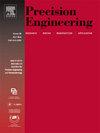Compliance and stress characteristics of the notch-type flexure hinges constructed on cylindrical beams
IF 3.7
2区 工程技术
Q2 ENGINEERING, MANUFACTURING
Precision Engineering-Journal of the International Societies for Precision Engineering and Nanotechnology
Pub Date : 2025-05-18
DOI:10.1016/j.precisioneng.2025.05.011
引用次数: 0
Abstract
Notch-type flexure hinges constructed from cylindrical beams have significant applications in medical and precision engineering, as many biomedical materials and precious metals are commonly available in cylindrical forms. However, analytical research on cylindrical-beam-based notch-type (CBN) flexure hinges is limited in existing literature. This study focuses on the compliance and stress characteristics of CBN flexure hinges. Analytical compliance equations for the CBN flexure hinge are derived based on linear elasticity theory. However, the accuracy of these analytical calculations is limited. To address this, simplified empirical compliance formulas are developed based on finite element analyses, and their accuracy is experimentally validated. A parametric analysis of compliance is conducted to explore the impact of various structural parameters. Additionally, design maps for stress concentration factors and compliance-to-stress ratios are generated for CBN flexure hinges. Compared to classical rectangular-beam-based notch-type (RBN) flexure hinges, CBN flexure hinges exhibit both higher stress concentration effects and a more favorable compliance-to-stress ratio. At identical stress levels, the CBN hinge structure can achieve greater deformation capacity than conventional notch-type flexure hinges based on rectangular beams.
圆柱梁上的缺口型柔性铰链的柔度和应力特性
从圆柱梁构造的缺口型柔性铰链在医疗和精密工程中有重要的应用,因为许多生物医学材料和贵金属通常以圆柱形式提供。然而,现有文献对圆柱梁型缺口型柔性铰链的分析研究有限。本文主要研究了CBN柔性铰链的柔度和应力特性。基于线弹性理论,推导了CBN柔性铰链柔度解析方程。然而,这些分析计算的准确性是有限的。针对这一问题,提出了基于有限元分析的简化经验柔度公式,并对其精度进行了实验验证。对柔度进行参数化分析,探讨不同结构参数对柔度的影响。此外,还生成了CBN柔性铰链应力集中系数和柔应力比的设计图。与经典的矩形梁缺口型(RBN)柔性铰链相比,CBN柔性铰链具有更高的应力集中效应和更有利的柔应力比。在相同应力水平下,CBN铰链结构比基于矩形梁的传统缺口型柔性铰链具有更大的变形能力。
本文章由计算机程序翻译,如有差异,请以英文原文为准。
求助全文
约1分钟内获得全文
求助全文
来源期刊
CiteScore
7.40
自引率
5.60%
发文量
177
审稿时长
46 days
期刊介绍:
Precision Engineering - Journal of the International Societies for Precision Engineering and Nanotechnology is devoted to the multidisciplinary study and practice of high accuracy engineering, metrology, and manufacturing. The journal takes an integrated approach to all subjects related to research, design, manufacture, performance validation, and application of high precision machines, instruments, and components, including fundamental and applied research and development in manufacturing processes, fabrication technology, and advanced measurement science. The scope includes precision-engineered systems and supporting metrology over the full range of length scales, from atom-based nanotechnology and advanced lithographic technology to large-scale systems, including optical and radio telescopes and macrometrology.

 求助内容:
求助内容: 应助结果提醒方式:
应助结果提醒方式:


